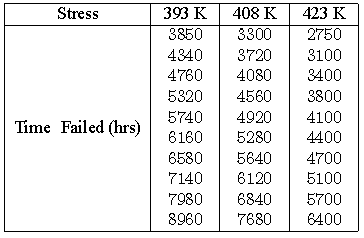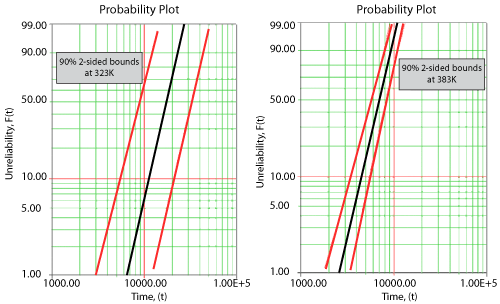| [math]\displaystyle{ f(t,V)=\frac{\beta }{C\cdot {{e}^{\frac{B}{V}}}}{{\left( \frac{t}{C\cdot {{e}^{\tfrac{B}{V}}}} \right)}^{\beta -1}}{{e}^{-{{\left( \tfrac{t}{C\cdot {{e}^{\tfrac{B}{V}}}} \right)}^{\beta }}}} }[/math]
|
New format available! This reference is now available in a new format that offers faster page load, improved display for calculations and images, more targeted search and the latest content available as a PDF. As of September 2023, this Reliawiki page will not continue to be updated. Please update all links and bookmarks to the latest reference at help.reliasoft.com/reference/accelerated_life_testing_data_analysis
The Arrhenius life-stress model (or relationship) is probably the most common life-stress relationship utilized in accelerated life testing. It has been widely used when the stimulus or acceleration variable (or stress) is thermal (i.e., temperature). It is derived from the Arrhenius reaction rate equation proposed by the Swedish physical chemist Svandte Arrhenius in 1887.
Formulation
The Arrhenius reaction rate equation is given by:
- [math]\displaystyle{ R(T)=A{{e}^{-\tfrac{{{E}_{a}}}{k\cdot T}}}\,\! }[/math]
where:
- [math]\displaystyle{ R\,\! }[/math] is the speed of reaction.
- [math]\displaystyle{ A\,\! }[/math] is an unknown nonthermal constant.
- [math]\displaystyle{ {{E}_{a}}\,\! }[/math] is the activation energy [math]\displaystyle{ (\text{eV})\,\! }[/math].
- [math]\displaystyle{ k\,\! }[/math] is the Boltzmann's constant [math]\displaystyle{ (8.6173303\times {{10}^{-5}}\text{eV}{{\text{K}}^{-1}})\,\! }[/math].
- [math]\displaystyle{ T\,\! }[/math] is the absolute temperature [math]\displaystyle{ (\text{K})\,\! }[/math].
The activation energy is the energy that a molecule must have to participate in the reaction. In other words, the activation energy is a measure of the effect that temperature has on the reaction.
The Arrhenius life-stress model is formulated by assuming that life is proportional to the inverse reaction rate of the process, thus the Arrhenius life-stress relationship is given by:
- [math]\displaystyle{ L(V)=C{{e}^{\tfrac{B}{V}}}\,\! }[/math]
where:
- [math]\displaystyle{ L\,\! }[/math] represents a quantifiable life measure, such as mean life, characteristic life, median life, or [math]\displaystyle{ B(x)\,\! }[/math] life, etc.
- [math]\displaystyle{ V\,\! }[/math] represents the stress level (formulated for temperature and temperature values in absolute units, degrees Kelvin or degrees Rankine).
- [math]\displaystyle{ C\,\! }[/math] is one of the model parameters to be determined, [math]\displaystyle{ (C\gt 0)\,\! }[/math].
- [math]\displaystyle{ B\,\! }[/math] is another model parameter to be determined.
Since the Arrhenius is a physics-based model derived for temperature dependence, it is used for temperature accelerated tests. For the same reason, temperature values must be in absolute units (Kelvin or Rankine), even though the Arrhenius equation is unitless.
Life Stress Plots
The Arrhenius relationship can be linearized and plotted on a Life vs. Stress plot, also called the Arrhenius plot. The relationship is linearized by taking the natural logarithm of both sides in the Arrhenius equation or:
- [math]\displaystyle{ ln(L(V))=ln(C)+\frac{B}{V}\,\! }[/math]
In the linearized Arrhenius equation, [math]\displaystyle{ \ln (C)\,\! }[/math] is the intercept of the line and [math]\displaystyle{ B\,\! }[/math] is the slope of the line. Note that the inverse of the stress, and not the stress, is the variable. In the above figure, life is plotted versus stress and not versus the inverse stress. This is because the linearized Arrhenius equation was plotted on a reciprocal scale. On such a scale, the slope [math]\displaystyle{ B\,\! }[/math] appears to be negative even though it has a positive value. This is because [math]\displaystyle{ B\,\! }[/math] is actually the slope of the reciprocal of the stress and not the slope of the stress. The reciprocal of the stress is decreasing as stress is increasing ( [math]\displaystyle{ \tfrac{1}{V}\,\! }[/math] is decreasing as [math]\displaystyle{ V\,\! }[/math] is increasing). The two different axes are shown in the next figure.
The Arrhenius relationship is plotted on a reciprocal scale for practical reasons. For example, in the above figure it is more convenient to locate the life corresponding to a stress level of 370K than to take the reciprocal of 370K (0.0027) first, and then locate the corresponding life.
The shaded areas shown in the above figure are the imposed at each test stress level. From such imposed pdfs one can see the range of the life at each test stress level, as well as the scatter in life. The next figure illustrates a case in which there is a significant scatter in life at each of the test stress levels.
Activation Energy and the Parameter B
Depending on the application (and where the stress is exclusively thermal), the parameter [math]\displaystyle{ B\,\! }[/math] can be replaced by:
- [math]\displaystyle{ B=\frac{{{E}_{a}}}{k}=\frac{\text{activation energy}}{\text{Boltzman}{{\text{n}}^{\prime }}\text{s constant}}=\frac{\text{activation energy}}{8.617385\times {{10}^{-5}}\text{eV}{{\text{K}}^{-1}}}\,\! }[/math]
Note that in this formulation, the activation energy [math]\displaystyle{ {{E}_{a}}\,\! }[/math] must be known a priori. If the activation energy is known then there is only one model parameter remaining, [math]\displaystyle{ C.\,\! }[/math] Because in most real life situations this is rarely the case, all subsequent formulations will assume that this activation energy is unknown and treat [math]\displaystyle{ B\,\! }[/math] as one of the model parameters. [math]\displaystyle{ B\,\! }[/math] has the same properties as the activation energy. In other words, [math]\displaystyle{ B\,\! }[/math] is a measure of the effect that the stress (i.e. temperature) has on the life. The larger the value of [math]\displaystyle{ B,\,\! }[/math] the higher the dependency of the life on the specific stress. Parameter [math]\displaystyle{ B\,\! }[/math] may also take negative values. In that case, life is increasing with increasing stress. An example of this would be plasma filled bulbs, where low temperature is a higher stress on the bulbs than high temperature.
Acceleration Factor
Most practitioners use the term acceleration factor to refer to the ratio of the life (or acceleration characteristic) between the use level and a higher test stress level or:
- [math]\displaystyle{ {{A}_{F}}=\frac{{{L}_{USE}}}{{{L}_{Accelerated}}}\,\! }[/math]
For the Arrhenius model this factor is:
- [math]\displaystyle{ {{A}_{F}}=\frac{{{L}_{USE}}}{{{L}_{Accelerated}}}=\frac{C\text{ }{{e}^{\tfrac{B}{{{V}_{u}}}}}}{C\text{ }{{e}^{\tfrac{B}{{{V}_{A}}}}}}=\frac{\text{ }{{e}^{\tfrac{B}{{{V}_{u}}}}}}{\text{ }{{e}^{\tfrac{B}{{{V}_{A}}}}}}={{e}^{\left( \tfrac{B}{{{V}_{u}}}-\tfrac{B}{{{V}_{A}}} \right)}}\,\! }[/math]
Thus, if [math]\displaystyle{ B\,\! }[/math] is assumed to be known a priori (using an activation energy), the assumed activation energy alone dictates this acceleration factor!
Arrhenius-Exponential
The pdf of the 1-parameter exponential distribution is given by:
- [math]\displaystyle{ \begin{align}
f(t)=\lambda {{e}^{-\lambda t}}
\end{align}\,\! }[/math]
It can be easily shown that the mean life for the 1-parameter exponential distribution (presented in detail here) is given by:
- [math]\displaystyle{ \lambda =\frac{1}{m}\,\! }[/math]
thus:
- [math]\displaystyle{ f(t)=\frac{1}{m}{{e}^{-\tfrac{t}{m}}}\,\! }[/math]
The Arrhenius-exponential model pdf can then be obtained by setting [math]\displaystyle{ m=L(V)\,\! }[/math]:
Therefore:
- [math]\displaystyle{ m=L(V)=C{{e}^{\tfrac{B}{V}}}\,\! }[/math]
Substituting for [math]\displaystyle{ m\,\! }[/math] yields a pdf that is both a function of time and stress or:
- [math]\displaystyle{ f(t,V)=\frac{1}{C{{e}^{\tfrac{B}{V}}}}\cdot {{e}^{-\tfrac{1}{C{{e}^{\tfrac{B}{V}}}}\cdot t}}\,\! }[/math]
Arrhenius-Exponential Statistical Properties Summary
Mean or MTTF
The mean, [math]\displaystyle{ \overline{T},\,\! }[/math] or Mean Time To Failure (MTTF) of the Arrhenius-exponential is given by,
- [math]\displaystyle{ \begin{align}
\overline{T}=\int_{0}^{\infty }t\cdot f(t,V)dt=\int_{0}^{\infty }t\cdot \frac{1}{C{{e}^{\tfrac{B}{V}}}}{{e}^{-\tfrac{t}{C{{e}^{\tfrac{B}{V}}}}}}dt =\ C{{e}^{\tfrac{B}{V}}}
\end{align}\,\! }[/math]
Median
The median, [math]\displaystyle{ \breve{T}\,\! }[/math] of the Arrhenius-exponential model is given by:
- [math]\displaystyle{ \breve{T}=0.693\cdot C{{e}^{\tfrac{B}{V}}}\,\! }[/math]
Mode
The mode, [math]\displaystyle{ \tilde{T},\,\! }[/math] of the Arrhenius-exponential model is given by:
- [math]\displaystyle{ \tilde{T}=0\,\! }[/math]
Standard Deviation
The standard deviation, [math]\displaystyle{ {{\sigma }_{T}}\,\! }[/math], of the Arrhenius-exponential model is given by:
- [math]\displaystyle{ {{\sigma }_{T}}=C{{e}^{\tfrac{B}{V}}}\,\! }[/math]
Arrhenius-Exponential Reliability Function
The Arrhenius-exponential reliability function is given by:
- [math]\displaystyle{ R(T,V)={{e}^{-\tfrac{T}{C{{e}^{\tfrac{B}{V}}}}}}\,\! }[/math]
This function is the complement of the Arrhenius-exponential cumulative distribution function or:
- [math]\displaystyle{ R(T,V)=1-Q(T,V)=1-\int_{0}^{T}f(T,V)dT\,\! }[/math]
and:
- [math]\displaystyle{ R(T,V)=1-\int_{0}^{T}\frac{1}{C{{e}^{\tfrac{B}{V}}}}{{e}^{-\tfrac{T}{C{{e}^{\tfrac{B}{V}}}}}}dT={{e}^{-\tfrac{T}{C{{e}^{\tfrac{B}{V}}}}}}\,\! }[/math]
Conditional Reliability
The Arrhenius-exponential conditional reliability function is given by:
- [math]\displaystyle{ R((t|T),V)=\frac{R(T+t,V)}{R(T,V)}=\frac{{{e}^{-\lambda (T+t)}}}{{{e}^{-\lambda T}}}={{e}^{-\tfrac{t}{C{{e}^{\tfrac{B}{V}}}}}}\,\! }[/math]
Reliable Life
For the Arrhenius-exponential model, the reliable life, or the mission duration for a desired reliability goal, [math]\displaystyle{ {{t}_{R}},\,\! }[/math] is given by:
- [math]\displaystyle{ R({{t}_{R}},V)={{e}^{-\tfrac{{{t}_{R}}}{C{{e}^{\tfrac{B}{V}}}}}}\,\! }[/math]
- [math]\displaystyle{ \ln [R({{t}_{R}},V)]=-\frac{{{t}_{R}}}{C{{e}^{\tfrac{B}{V}}}}\,\! }[/math]
or:
- [math]\displaystyle{ {{t}_{R}}=-C{{e}^{\tfrac{B}{V}}}\ln [R({{t}_{R}},V)]\,\! }[/math]
Parameter Estimation
Maximum Likelihood Estimation Method
The log-likelihood function for the exponential distribution is as shown next:
- [math]\displaystyle{ \begin{align}
& \ln (L)= & \Lambda =\underset{i=1}{\overset{{{F}_{e}}}{\mathop \sum }}\,{{N}_{i}}\ln \left[ \lambda {{e}^{-\lambda {{T}_{i}}}} \right]-\underset{i=1}{\overset{S}{\mathop \sum }}\,N_{i}^{\prime }\lambda T_{i}^{\prime } \
& \overset{FI}{\mathop{\underset{i=1}{\mathop{+\underset{}{\overset{}{\mathop \sum }}\,}}\,}}\,N_{i}^{\prime \prime }\ln [R_{Li}^{\prime \prime }-R_{Ri}^{\prime \prime }]
\end{align}\,\! }[/math]
where:
- [math]\displaystyle{ R_{Li}^{\prime \prime }={{e}^{-\lambda T_{Li}^{\prime \prime }}}\,\! }[/math]
- [math]\displaystyle{ R_{Ri}^{\prime \prime }={{e}^{-\lambda T_{Ri}^{\prime \prime }}}\,\! }[/math]
and:
- [math]\displaystyle{ {{F}_{e}}\,\! }[/math] is the number of groups of exact times-to-failure data points.
- [math]\displaystyle{ {{N}_{i}}\,\! }[/math] is the number of times-to-failure in the [math]\displaystyle{ {{i}^{th}}\,\! }[/math] time-to-failure data group.
- [math]\displaystyle{ \lambda \,\! }[/math] is the failure rate parameter (unknown).
- [math]\displaystyle{ {{T}_{i}}\,\! }[/math] is the exact failure time of the [math]\displaystyle{ {{i}^{th}}\,\! }[/math] group.
- [math]\displaystyle{ S\,\! }[/math] is the number of groups of suspension data points.
- [math]\displaystyle{ N_{i}^{\prime }\,\! }[/math] is the number of suspensions in the [math]\displaystyle{ {{i}^{th}}\,\! }[/math] group of suspension data points.
- [math]\displaystyle{ T_{i}^{\prime }\,\! }[/math] is the time of the [math]\displaystyle{ {{i}^{th}}\,\! }[/math] suspension data group.
- [math]\displaystyle{ FI\,\! }[/math] is the number of interval data groups.
- [math]\displaystyle{ N_{i}^{\prime \prime }\,\! }[/math] is the number of intervals in the [math]\displaystyle{ {{i}^{th}}\,\! }[/math] group of data intervals.
- [math]\displaystyle{ T_{Li}^{\prime \prime }\,\! }[/math] is the beginning of the [math]\displaystyle{ {{i}^{th}}\,\! }[/math] interval.
- [math]\displaystyle{ T_{Ri}^{\prime \prime }\,\! }[/math] is the ending of the [math]\displaystyle{ {{i}^{th}}\,\! }[/math] interval.
Substituting the Arrhenius-exponential model into the log-likelihood function yields:
- [math]\displaystyle{ \begin{align}
\Lambda = \underset{i=1}{\overset{{{F}_{e}}}{\mathop \sum }}\,{{N}_{i}}\ln \left[ \frac{1}{C\cdot {{e}^{\tfrac{B}{{{V}_{i}}}}}}{{e}^{-\tfrac{1}{C\cdot {{e}^{\tfrac{B}{{{V}_{i}}}}}}{{T}_{i}}}} \right] -\underset{i=1}{\overset{S}{\mathop \sum }}\,N_{i}^{\prime }\frac{1}{C\cdot {{e}^{\tfrac{B}{{{V}_{i}}}}}}T_{i}^{\prime }+\overset{FI}{\mathop{\underset{i=1}{\mathop{\underset{}{\overset{}{\mathop \sum }}\,}}\,}}\,N_{i}^{\prime \prime }\ln [R_{Li}^{\prime \prime }-R_{Ri}^{\prime \prime }]
\end{align}\,\! }[/math]
where:
- [math]\displaystyle{ R_{Li}^{\prime \prime }={{e}^{-\tfrac{T_{Li}^{\prime \prime }}{C{{e}^{\tfrac{B}{{{V}_{i}}}}}}}}\,\! }[/math]
- [math]\displaystyle{ R_{Ri}^{\prime \prime }={{e}^{-\tfrac{T_{Ri}^{\prime \prime }}{C{{e}^{\tfrac{B}{{{V}_{i}}}}}}}}\,\! }[/math]
The solution (parameter estimates) will be found by solving for the parameters [math]\displaystyle{ \widehat{B},\,\! }[/math] [math]\displaystyle{ \widehat{C}\,\! }[/math] so that [math]\displaystyle{ \tfrac{\partial \Lambda }{\partial B}=0\,\! }[/math] and [math]\displaystyle{ \tfrac{\partial \Lambda }{\partial C}=0\,\! }[/math], where:
- [math]\displaystyle{ \begin{align}
& \frac{\partial \Lambda }{\partial B}= & \frac{1}{C}\underset{i=1}{\overset{{{F}_{e}}}{\mathop \sum }}\,{{N}_{i}}\left( \frac{{{T}_{i}}}{{{V}_{i}}{{e}^{\tfrac{B}{{{V}_{i}}}}}}-\frac{C}{{{V}_{i}}} \right)+\frac{1}{C}\underset{i=1}{\overset{S}{\mathop \sum }}\,N_{i}^{\prime }\frac{T_{i}^{\prime }}{{{V}_{i}}{{e}^{\tfrac{B}{{{V}_{i}}}}}} \overset{FI}{\mathop{\underset{i=1}{\mathop{+\underset{}{\overset{}{\mathop \sum }}\,}}\,}}\,N_{i}^{\prime \prime }\frac{T_{Li}^{\prime \prime }R_{Li}^{\prime \prime }-T_{Ri}^{\prime \prime }R_{Ri}^{\prime \prime }}{(R_{Li}^{\prime \prime }-R_{Ri}^{\prime \prime })C{{V}_{i}}{{e}^{\tfrac{B}{{{V}_{i}}}}}}
\end{align}\,\! }[/math]
- [math]\displaystyle{ \begin{align}
& \frac{\partial \Lambda }{\partial C}= & \frac{1}{C}\underset{i=1}{\overset{{{F}_{e}}}{\mathop \sum }}\,{{N}_{i}}\left( \frac{{{T}_{i}}}{C{{e}^{\tfrac{B}{{{V}_{i}}}}}}-1 \right)+\frac{1}{{{C}^{2}}}\underset{i=1}{\overset{S}{\mathop \sum }}\,N_{i}^{\prime }\frac{T_{i}^{\prime }}{{{e}^{\tfrac{B}{{{V}_{i}}}}}} \overset{FI}{\mathop{\underset{i=1}{\mathop{+\underset{}{\overset{}{\mathop \sum }}\,}}\,}}\,N_{i}^{\prime \prime }\frac{T_{Li}^{\prime \prime }R_{Li}^{\prime \prime }-T_{Ri}^{\prime \prime }R_{Ri}^{\prime \prime }}{(R_{Li}^{\prime \prime }-R_{Ri}^{\prime \prime }){{C}^{2}}{{e}^{\tfrac{B}{{{V}_{i}}}}}}
\end{align}\,\! }[/math]
Arrhenius-Weibull
The pdf for the 2-parameter Weibull distribution is given by:
- [math]\displaystyle{ f(t)=\frac{\beta }{\eta }{{\left( \frac{t}{\eta } \right)}^{\beta -1}}{{e}^{-{{\left( \tfrac{t}{\eta } \right)}^{\beta }}}}\,\! }[/math]
The scale parameter (or characteristic life) of the Weibull distribution is [math]\displaystyle{ \eta \,\! }[/math].
The Arrhenius-Weibull model pdf can then be obtained by setting [math]\displaystyle{ \eta =L(V)\,\! }[/math]:
- [math]\displaystyle{ \eta =L(V)=C\cdot {{e}^{\tfrac{B}{V}}}\,\! }[/math]
and substituting for [math]\displaystyle{ \eta \,\! }[/math] in the 2-parameter Weibull distribution equation:
- [math]\displaystyle{ f(t,V)=\frac{\beta }{C\cdot {{e}^{\tfrac{B}{V}}}}{{\left( \frac{t}{C\cdot {{e}^{\tfrac{B}{V}}}} \right)}^{\beta -1}}{{e}^{-{{\left( \tfrac{t}{C\cdot {{e}^{\tfrac{B}{V}}}} \right)}^{\beta }}}}\,\! }[/math]
An illustration of the pdf for different stresses is shown in the next figure. As expected, the pdf at lower stress levels is more stretched to the right, with a higher scale parameter, while its shape remains the same (the shape parameter is approximately 3). This behavior is observed when the parameter [math]\displaystyle{ B\,\! }[/math] of the Arrhenius model is positive.
The advantage of using the Weibull distribution as the life distribution lies in its flexibility to assume different shapes. The Weibull distribution is presented in greater detail in The Weibull Distribution.
Arrhenius-Weibull Statistical Properties Summary
Mean or MTTF
The mean, [math]\displaystyle{ \overline{T}\,\! }[/math] (also called [math]\displaystyle{ MTTF\,\! }[/math] by some authors), of the Arrhenius-Weibull relationship is given by:
- [math]\displaystyle{ \overline{T}=C\cdot {{e}^{\tfrac{B}{V}}}\cdot \Gamma \left( \frac{1}{\beta }+1 \right)\,\! }[/math]
where [math]\displaystyle{ \Gamma \left( \tfrac{1}{\beta }+1 \right)\,\! }[/math] is the gamma function evaluated at the value of [math]\displaystyle{ \left( \tfrac{1}{\beta }+1 \right)\,\! }[/math].
Median
The median, [math]\displaystyle{ \breve{T},\,\! }[/math]
for the Arrhenius-Weibull model is given by:
- [math]\displaystyle{ \breve{T}=C\cdot {{e}^{\tfrac{B}{V}}}{{\left( \ln 2 \right)}^{\tfrac{1}{\beta }}}\,\! }[/math]
Mode
The mode, [math]\displaystyle{ \tilde{T},\,\! }[/math]
for the Arrhenius-Weibull model is given by:
- [math]\displaystyle{ \tilde{T}=C\cdot {{e}^{\tfrac{B}{V}}}{{\left( 1-\frac{1}{\beta } \right)}^{\tfrac{1}{\beta }}}\,\! }[/math]
Standard Deviation
The standard deviation, [math]\displaystyle{ {{\sigma }_{T}},\,\! }[/math] for the Arrhenius-Weibull model is given by:
- [math]\displaystyle{ {{\sigma }_{T}}=C\cdot {{e}^{\tfrac{B}{V}}}\cdot \sqrt{\Gamma \left( \frac{2}{\beta }+1 \right)-{{\left( \Gamma \left( \frac{1}{\beta }+1 \right) \right)}^{2}}}\,\! }[/math]
Arrhenius-Weibull Reliability Function
The Arrhenius-Weibull reliability function is given by:
- [math]\displaystyle{ R(T,V)={{e}^{-{{\left( \tfrac{T}{C\cdot {{e}^{\tfrac{B}{V}}}} \right)}^{\beta }}}}\,\! }[/math]
If the parameter [math]\displaystyle{ B\,\! }[/math] is positive, then the reliability increases as stress decreases.
The behavior of the reliability function of the Weibull distribution for different values of [math]\displaystyle{ \beta \,\! }[/math] was illustrated here. In the case of the Arrhenius-Weibull model, however, the reliability is a function of stress also. A 3D plot such as the ones shown in the next figure is now needed to illustrate the effects of both the stress and [math]\displaystyle{ \beta .\,\! }[/math]
Conditional Reliability Function
The Arrhenius-Weibull conditional reliability function at a specified stress level is given by:
- [math]\displaystyle{ R((t|T),V)=\frac{R(T+t,V)}{R(T,V)}=\frac{{{e}^{-{{\left( \tfrac{T+t}{\eta } \right)}^{\beta }}}}}{{{e}^{-{{\left( \tfrac{T}{\eta } \right)}^{\beta }}}}}\,\! }[/math]
or:
- [math]\displaystyle{ R((t|T),V)={{e}^{-\left[ {{\left( \tfrac{T+t}{C\cdot {{e}^{\tfrac{B}{V}}}} \right)}^{\beta }}-{{\left( \tfrac{T}{C\cdot {{e}^{\tfrac{B}{V}}}} \right)}^{\beta }} \right]}}\,\! }[/math]
Reliable Life
For the Arrhenius-Weibull relationship, the reliable life, [math]\displaystyle{ {{t}_{R}}\,\! }[/math], of a unit for a specified reliability and starting the mission at age zero is given by:
- [math]\displaystyle{ {{t}_{R}}=C\cdot {{e}^{\tfrac{B}{V}}}{{\left\{ -\ln \left[ R\left( {{t}_{R}},V \right) \right] \right\}}^{\tfrac{1}{\beta }}}\,\! }[/math]
This is the life for which the unit will function successfully with a reliability of [math]\displaystyle{ R({{t}_{R}})\,\! }[/math]. If [math]\displaystyle{ R({{t}_{R}})=0.50\,\! }[/math] then [math]\displaystyle{ {{t}_{R}}=\breve{T}\,\! }[/math], the median life, or the life by which half of the units will survive.
Arrhenius-Weibull Failure Rate Function
The Arrhenius-Weibull failure rate function, [math]\displaystyle{ \lambda (T)\,\! }[/math], is given by:
- [math]\displaystyle{ \lambda \left( T,V \right)=\frac{f\left( T,V \right)}{R\left( T,V \right)}=\frac{\beta }{C\cdot {{e}^{\tfrac{B}{V}}}}{{\left( \frac{T}{C\cdot {{e}^{\tfrac{B}{V}}}} \right)}^{\beta -1}}\,\! }[/math]
Parameter Estimation
Maximum Likelihood Estimation Method
The Arrhenius-Weibull log-likelihood function is as follows:
- [math]\displaystyle{ \begin{align}
& \Lambda = & \underset{i=1}{\overset{{{F}_{e}}}{\mathop \sum }}\,{{N}_{i}}\ln \left[ \frac{\beta }{C\cdot {{e}^{\tfrac{B}{{{V}_{i}}}}}}{{\left( \frac{{{T}_{i}}}{C\cdot {{e}^{\tfrac{B}{{{V}_{i}}}}}} \right)}^{\beta -1}}{{e}^{-{{\left( \tfrac{{{T}_{i}}}{C\cdot {{e}^{\tfrac{B}{{{V}_{i}}}}}} \right)}^{\beta }}}} \right] \ -\underset{i=1}{\overset{S}{\mathop \sum }}\,N_{i}^{\prime }{{\left( \frac{T_{i}^{\prime }}{C\cdot {{e}^{\tfrac{B}{{{V}_{i}}}}}} \right)}^{\beta }}+\overset{FI}{\mathop{\underset{i=1}{\mathop{\underset{}{\overset{}{\mathop \sum }}\,}}\,}}\,N_{i}^{\prime \prime }\ln [R_{Li}^{\prime \prime }-R_{Ri}^{\prime \prime }]
\end{align}\,\! }[/math]
where:
- [math]\displaystyle{ R_{Li}^{\prime \prime }={{e}^{-{{\left( \tfrac{T_{Li}^{\prime \prime }}{C{{e}^{\tfrac{B}{{{V}_{i}}}}}} \right)}^{\beta }}}}\,\! }[/math]
- [math]\displaystyle{ R_{Ri}^{\prime \prime }={{e}^{-{{\left( \tfrac{T_{Ri}^{\prime \prime }}{C{{e}^{\tfrac{B}{{{V}_{i}}}}}} \right)}^{\beta }}}}\,\! }[/math]
and:
- [math]\displaystyle{ {{F}_{e}}\,\! }[/math] is the number of groups of exact times-to-failure data points.
- [math]\displaystyle{ {{N}_{i}}\,\! }[/math] is the number of times-to-failure data points in the [math]\displaystyle{ {{i}^{th}}\,\! }[/math] time-to-failure data group.
- [math]\displaystyle{ \beta \,\! }[/math] is the Weibull shape parameter (unknown, the first of three parameters to be estimated).
- [math]\displaystyle{ B\,\! }[/math] is the Arrhenius parameter (unknown, the second of three parameters to be estimated).
- [math]\displaystyle{ C\,\! }[/math] is the second Arrhenius parameter (unknown, the third of three parameters to be estimated).
- [math]\displaystyle{ {{V}_{i}}\,\! }[/math] is the stress level of the [math]\displaystyle{ {{i}^{th}}\,\! }[/math] group.
- [math]\displaystyle{ {{T}_{i}}\,\! }[/math] is the exact failure time of the [math]\displaystyle{ {{i}^{th}}\,\! }[/math] group.
- [math]\displaystyle{ S\,\! }[/math] is the number of groups of suspension data points.
- [math]\displaystyle{ N_{i}^{\prime }\,\! }[/math] is the number of suspensions in the [math]\displaystyle{ {{i}^{th}}\,\! }[/math] group of suspension data points.
- [math]\displaystyle{ T_{i}^{\prime }\,\! }[/math] is the running time of the [math]\displaystyle{ {{i}^{th}}\,\! }[/math] suspension data group.
- [math]\displaystyle{ FI\,\! }[/math] is the number of interval data groups.
- [math]\displaystyle{ N_{i}^{\prime \prime }\,\! }[/math] is the number of intervals in the [math]\displaystyle{ {{i}^{th}}\,\! }[/math] group of data intervals.
- [math]\displaystyle{ T_{Li}^{\prime \prime }\,\! }[/math] is the beginning of the [math]\displaystyle{ {{i}^{th}}\,\! }[/math] interval.
- [math]\displaystyle{ T_{Ri}^{\prime \prime }\,\! }[/math] is the ending of the [math]\displaystyle{ {{i}^{th}}\,\! }[/math] interval.
The solution (parameter estimates) will be found by solving for [math]\displaystyle{ \widehat{\beta },\,\! }[/math] [math]\displaystyle{ \widehat{B},\,\! }[/math] [math]\displaystyle{ \widehat{C}\,\! }[/math] so that [math]\displaystyle{ \tfrac{\partial \Lambda }{\partial \beta }=0,\,\! }[/math] [math]\displaystyle{ \tfrac{\partial \Lambda }{\partial B}=0\,\! }[/math] and [math]\displaystyle{ \tfrac{\partial \Lambda }{\partial C}=0\,\! }[/math], where:
- [math]\displaystyle{ \begin{align}
\frac{\partial \Lambda }{\partial \beta }=\ & \frac{1}{\beta }\underset{i=1}{\overset{{{F}_{e}}}{\mathop{\sum }}}\,{{N}_{i}}+\underset{i=1}{\overset{{{F}_{e}}}{\mathop{\sum }}}\,{{N}_{i}}\ln \left( \frac{{{T}_{i}}}{C\cdot {{e}^{\tfrac{B}{{{V}_{i}}}}}} \right) -\underset{i=1}{\overset{{{F}_{e}}}{\mathop{\sum }}}\,{{N}_{i}}{{\left( \frac{{{T}_{i}}}{C\cdot {{e}^{\tfrac{B}{{{V}_{i}}}}}} \right)}^{\beta }}\ln \left( \frac{{{T}_{i}}}{C\cdot {{e}^{\tfrac{B}{{{V}_{i}}}}}} \right) -\underset{i=1}{\overset{S}{\mathop{\sum }}}\,N_{i}^{\prime }{{\left( \frac{T_{i}^{\prime }}{C\cdot {{e}^{\tfrac{B}{{{V}_{i}}}}}} \right)}^{\beta }}\ln \left( \frac{T_{i}^{\prime }}{C\cdot {{e}^{\tfrac{B}{{{V}_{i}}}}}} \right) \\
& \overset{FI}{\mathop{\underset{i=1}{\mathop{-\underset{}{\overset{}{\mathop \sum }}\,}}\,}}\,N_{i}^{\prime \prime }\frac{{{\left( \tfrac{T_{Li}^{\prime \prime }}{C{{e}^{\tfrac{B}{{{V}_{i}}}}}} \right)}^{\beta }}\ln \left( \tfrac{T_{Li}^{\prime \prime }}{C{{e}^{\tfrac{B}{{{V}_{i}}}}}} \right)R_{Li}^{\prime \prime }-{{\left( \tfrac{T_{Ri}^{\prime \prime }}{C{{e}^{\tfrac{B}{{{V}_{i}}}}}} \right)}^{\beta }}\ln \left( \tfrac{T_{Ri}^{\prime \prime }}{C{{e}^{\tfrac{B}{{{V}_{i}}}}}} \right)R_{Ri}^{\prime \prime }}{R_{Li}^{\prime \prime }-R_{Ri}^{\prime \prime }}
\end{align}\,\! }[/math]
- [math]\displaystyle{ \begin{align}
& \frac{\partial \Lambda }{\partial B}= -\beta \underset{i=1}{\overset{{{F}_{e}}}{\mathop{\sum }}}\,{{N}_{i}}\frac{1}{{{V}_{i}}}+\beta \underset{i=1}{\overset{{{F}_{e}}}{\mathop{\sum }}}\,{{N}_{i}}\frac{1}{{{V}_{i}}}{{\left( \frac{{{T}_{i}}}{\widehat{C}{{e}^{\tfrac{\widehat{B}}{{{V}_{i}}}}}} \right)}^{\beta }}+\beta \underset{i=1}{\overset{S}{\mathop{\sum }}}\,N_{i}^{\prime }\frac{1}{{{V}_{i}}}{{\left( \frac{T_{i}^{\prime }}{\widehat{C}{{e}^{\tfrac{\widehat{B}}{{{V}_{i}}}}}} \right)}^{\beta }} +\overset{FI}{\mathop{\underset{i=1}{\mathop{\underset{}{\overset{}{\mathop \sum }}\,}}\,}}\,N_{i}^{\prime \prime }\frac{\beta }{{{V}_{i}}}\frac{{{(T_{Li}^{\prime \prime })}^{\beta }}R_{Li}^{\prime \prime }-{{(T_{Ri}^{\prime \prime })}^{\beta }}R_{Ri}^{\prime \prime }}{{{\left( C{{e}^{\tfrac{B}{{{V}_{i}}}}} \right)}^{\beta }}\left( R_{Li}^{\prime \prime }-R_{Ri}^{\prime \prime } \right)}
\end{align}\,\! }[/math]
- [math]\displaystyle{ \begin{align}
& \frac{\partial \Lambda }{\partial C}= -\frac{\beta }{C}\underset{i=1}{\overset{{{F}_{e}}}{\mathop{\sum }}}\,{{N}_{i}}+\frac{\beta }{C}\underset{i=1}{\overset{{{F}_{e}}}{\mathop{\sum }}}\,{{N}_{i}}{{\left( \frac{{{T}_{i}}}{C\cdot {{e}^{\tfrac{B}{{{V}_{i}}}}}} \right)}^{\beta }}+\frac{\beta }{C}\underset{i=1}{\overset{S}{\mathop{\sum }}}\,N_{i}^{\prime }{{\left( \frac{T_{i}^{\prime }}{C\cdot {{e}^{\tfrac{B}{{{V}_{i}}}}}} \right)}^{\beta }} +\overset{FI}{\mathop{\underset{i=1}{\mathop{\underset{}{\overset{}{\mathop \sum }}\,}}\,}}\,N_{i}^{\prime \prime }\frac{\beta }{C}\frac{{{(T_{Li}^{\prime \prime })}^{\beta }}R_{Li}^{\prime \prime }-{{(T_{Ri}^{\prime \prime })}^{\beta }}R_{Ri}^{\prime \prime }}{{{\left( C{{e}^{\tfrac{B}{{{V}_{i}}}}} \right)}^{\beta }}\left( R_{Li}^{\prime \prime }-R_{Ri}^{\prime \prime } \right)}
\end{align}\,\! }[/math]
Arrhenius-Weibull example
Consider the following times-to-failure data at three different stress levels.
The data set was analyzed jointly and with a complete MLE solution over the entire data set, using ReliaSoft's ALTA. The analysis yields:
- [math]\displaystyle{ \widehat{\beta }=4.2915822\,\! }[/math]
- [math]\displaystyle{ \widehat{B}=1861.6186657\,\! }[/math]
- [math]\displaystyle{ \widehat{C}=58.9848692\,\! }[/math]
Once the parameters of the model are estimated, extrapolation and other life measures can be directly obtained using the appropriate equations. Using the MLE method, confidence bounds for all estimates can be obtained. Note that in the next figure, the more distant the accelerated stress is from the operating stress, the greater the uncertainty of the extrapolation. The degree of uncertainty is reflected in the confidence bounds. (General theory and calculations for confidence intervals are presented in Appendix A. Specific calculations for confidence bounds on the Arrhenius model are presented in the Arrhenius Relationship chapter).
Arrhenius-Lognormal
The pdf of the lognormal distribution is given by:
- [math]\displaystyle{ f(T)=\frac{1}{T\text{ }{{\sigma }_{{{T}'}}}\sqrt{2\pi }}{{e}^{-\tfrac{1}{2}{{\left( \tfrac{{T}'-\bar{{{T}'}}}{{{\sigma }_{{{T}'}}}} \right)}^{2}}}}\,\! }[/math]
where:
- [math]\displaystyle{ \begin{align}
{T}'=\ln(T)
\end{align}\,\! }[/math]
and:
- [math]\displaystyle{ T=\,\! }[/math] times-to-failure.
- [math]\displaystyle{ {T}'=\,\! }[/math] mean of the natural logarithms of the times-to-failure.
- [math]\displaystyle{ {{\sigma }_{{{T}'}}}=\,\! }[/math] standard deviation of the natural logarithms of the times-to-failure.
The median of the lognormal distribution is given by:
- [math]\displaystyle{ \breve{T}={{e}^{{{\overline{T}}^{\prime }}}}\,\! }[/math]
The Arrhenius-lognormal model pdf can be obtained first by setting [math]\displaystyle{ \breve{T}=L(V)\,\! }[/math]. Therefore:
- [math]\displaystyle{ \breve{T}=L(V)=C{{e}^{\tfrac{B}{V}}}\,\! }[/math]
or:
- [math]\displaystyle{ {{e}^{{{\overline{T}}^{\prime }}}}=C{{e}^{\tfrac{B}{V}}}\,\! }[/math]
Thus:
- [math]\displaystyle{ {{\overline{T}}^{\prime }}=\ln (C)+\frac{B}{V}\,\! }[/math]
Substituting the above equation into the lognormal pdf yields the Arrhenius-lognormal model pdf or:
- [math]\displaystyle{ f(T,V)=\frac{1}{T\text{ }{{\sigma }_{{{T}'}}}\sqrt{2\pi }}{{e}^{-\tfrac{1}{2}{{\left( \tfrac{{T}'-\ln (C)-\tfrac{B}{V}}{{{\sigma }_{{{T}'}}}} \right)}^{2}}}}\,\! }[/math]
Note that in the Arrhenius-lognormal pdf, it was assumed that the standard deviation of the natural logarithms of the times-to-failure, [math]\displaystyle{ {{\sigma }_{{{T}'}}},\,\! }[/math] is independent of stress. This assumption implies that the shape of the distribution does not change with stress ( [math]\displaystyle{ {{\sigma }_{{{T}'}}}\,\! }[/math] is the shape parameter of the lognormal distribution).
Arrhenius-Lognormal Statistical Properties Summary
The Mean
- The mean life of the Arrhenius-lognormal model (mean of the times-to-failure), [math]\displaystyle{ \bar{T}\,\! }[/math], is given by:
- [math]\displaystyle{ \begin{align}
& \bar{T}= & {{e}^{\bar{{T}'}+\tfrac{1}{2}\sigma _{{{T}'}}^{2}}} =\ & {{e}^{\ln (C)+\tfrac{B}{V}+\tfrac{1}{2}\sigma _{{{T}'}}^{2}}}
\end{align}\,\! }[/math]
- The mean of the natural logarithms of the times-to-failure, [math]\displaystyle{ {{\bar{T}}^{^{\prime }}}\,\! }[/math], in terms of [math]\displaystyle{ \bar{T}\,\! }[/math] and [math]\displaystyle{ {{\sigma }_{T}}\,\! }[/math] is given by:
- [math]\displaystyle{ {{\bar{T}}^{\prime }}=\ln \left( {\bar{T}} \right)-\frac{1}{2}\ln \left( \frac{\sigma _{T}^{2}}{{{{\bar{T}}}^{2}}}+1 \right)\,\! }[/math]
The Standard Deviation
- The standard deviation of the Arrhenius-lognormal model (standard deviation of the times-to-failure), [math]\displaystyle{ {{\sigma }_{T}}\,\! }[/math], is given by:
- [math]\displaystyle{ \begin{align}
& {{\sigma }_{T}}= & \sqrt{\left( {{e}^{2\bar{{T}'}+\sigma _{{{T}'}}^{2}}} \right)\left( {{e}^{\sigma _{{{T}'}}^{2}}}-1 \right)} =\ & \sqrt{\left( {{e}^{2\left( \ln (C)+\tfrac{B}{V} \right)+\sigma _{{{T}'}}^{2}}} \right)\left( {{e}^{\sigma _{{{T}'}}^{2}}}-1 \right)}
\end{align}\,\! }[/math]
- The standard deviation of the natural logarithms of the times-to-failure, [math]\displaystyle{ {{\sigma }_{{{T}'}}}\,\! }[/math], in terms of [math]\displaystyle{ \bar{T}\,\! }[/math] and [math]\displaystyle{ {{\sigma }_{T}}\,\! }[/math] is given by:
- [math]\displaystyle{ {{\sigma }_{{{T}'}}}=\sqrt{\ln \left( \frac{\sigma _{T}^{2}}{{{{\bar{T}}}^{2}}}+1 \right)}\,\! }[/math]
The Mode
- The mode of the Arrhenius-lognormal model is given by:
- [math]\displaystyle{ \begin{align}
& \tilde{T}=\ {{e}^{{{\overline{T}}^{\prime }}-\sigma _{{{T}'}}^{2}}} =\ {{e}^{\ln (C)+\tfrac{B}{V}-\sigma _{{{T}'}}^{2}}}
\end{align}\,\! }[/math]
Arrhenius-Lognormal Reliability Function
The reliability for a mission of time [math]\displaystyle{ T\,\! }[/math], starting at age 0, for the Arrhenius-lognormal model is determined by:
- [math]\displaystyle{ R(T,V)=\int_{T}^{\infty }f(t,V)dt\,\! }[/math]
or:
- [math]\displaystyle{ R(T,V)=\int_{{{T}^{^{\prime }}}}^{\infty }\frac{1}{{{\sigma }_{{{T}'}}}\sqrt{2\pi }}{{e}^{-\tfrac{1}{2}{{\left( \tfrac{t-\ln (C)-\tfrac{B}{V}}{{{\sigma }_{{{T}'}}}} \right)}^{2}}}}dt\,\! }[/math]
There is no closed form solution for the lognormal reliability function. Solutions can be obtained via the use of standard normal tables. Since the application automatically solves for the reliability, we will not discuss manual solution methods.
Reliable Life
For the Arrhenius-lognormal model, the reliable life, or the mission duration for a desired reliability goal, [math]\displaystyle{ {{t}_{R}},\,\! }[/math] is estimated by first solving the reliability equation with respect to time, as follows:
- [math]\displaystyle{ {{T}'_{R}}= ln(C)+\frac{B}{V}+z \cdot {{\sigma}_{{T}'}}\,\! }[/math]
where:
- [math]\displaystyle{ z={{\Phi }^{-1}}\left[ F\left( T_{R}^{\prime },V \right) \right]\,\! }[/math]
and:
- [math]\displaystyle{ \Phi (z)=\frac{1}{\sqrt{2\pi }}\int_{-\infty }^{z({T}',V)}{{e}^{-\tfrac{{{t}^{2}}}{2}}}dt\,\! }[/math]
Since [math]\displaystyle{ {T}'=\ln (T)\,\! }[/math] the reliable life, [math]\displaystyle{ {{t}_{R}},\,\! }[/math] is given by:
- [math]\displaystyle{ {{t}_{R}}={{e}^{T_{R}^{\prime }}}\,\! }[/math]
Arrhenius-Lognormal Failure Rate
The Arrhenius-lognormal failure rate is given by:
- [math]\displaystyle{ \lambda (T,V)=\frac{f(T,V)}{R(T,V)}=\frac{\tfrac{1}{T\text{ }{{\sigma }_{{{T}'}}}\sqrt{2\pi }}{{e}^{-\tfrac{1}{2}{{\left( \tfrac{{T}'-\ln (C)-\tfrac{B}{V}}{{{\sigma }_{{{T}'}}}} \right)}^{2}}}}}{\int_{{{T}'}}^{\infty }\tfrac{1}{{{\sigma }_{{{T}'}}}\sqrt{2\pi }}{{e}^{-\tfrac{1}{2}{{\left( \tfrac{{T}'-\ln (C)-\tfrac{B}{V}}{{{\sigma }_{{{T}'}}}} \right)}^{2}}}}dt}\,\! }[/math]
Parameter Estimation
Maximum Likelihood Estimation Method
The lognormal log-likelihood function for the Arrhenius-lognormal model is as follows:
- [math]\displaystyle{ \begin{align}
& \ln (L)= & \Lambda =\underset{i=1}{\overset{{{F}_{e}}}{\mathop \sum }}\,{{N}_{i}}\ln \left[ \frac{1}{{{\sigma }_{{{T}'}}}{{T}_{i}}}\phi \left( \frac{\ln \left( {{T}_{i}} \right)-\ln (C)-\tfrac{B}{{{V}_{i}}}}{{{\sigma }_{{{T}'}}}} \right) \right] \text{ }+\underset{i=1}{\overset{S}{\mathop \sum }}\,N_{i}^{\prime }\ln \left[ 1-\Phi \left( \frac{\ln \left( T_{i}^{\prime } \right)-\ln (C)-\tfrac{B}{{{V}_{i}}}}{{{\sigma }_{{{T}'}}}} \right) \right] +\overset{FI}{\mathop{\underset{i=1}{\mathop{\underset{}{\overset{}{\mathop \sum }}\,}}\,}}\,N_{i}^{\prime \prime }\ln [\Phi (z_{Ri}^{\prime \prime })-\Phi (z_{Li}^{\prime \prime })]
\end{align}\,\! }[/math]
where:
- [math]\displaystyle{ z_{Li}^{\prime \prime }=\frac{\ln T_{Li}^{\prime \prime }-\ln C-\tfrac{B}{{{V}_{i}}}}{\sigma _{T}^{\prime }}\,\! }[/math]
- [math]\displaystyle{ z_{Ri}^{\prime \prime }=\frac{\ln T_{Ri}^{\prime \prime }-\ln C-\tfrac{B}{{{V}_{i}}}}{\sigma _{T}^{\prime }}\,\! }[/math]
and:
- [math]\displaystyle{ {{F}_{e}}\,\! }[/math] is the number of groups of exact times-to-failure data points.
- [math]\displaystyle{ {{N}_{i}}\,\! }[/math] is the number of times-to-failure data points in the [math]\displaystyle{ {{i}^{th}}\,\! }[/math] time-to-failure data group.
- [math]\displaystyle{ {{\sigma}_{{T}'}}\,\! }[/math] is the standard deviation of the natural logarithm of the times-to-failure (unknown, the first of three parameters to be estimated).
- [math]\displaystyle{ B\,\! }[/math] is the Arrhenius parameter (unknown, the second of three parameters to be estimated).
- [math]\displaystyle{ C\,\! }[/math] is the second Arrhenius parameter (unknown, the third of three parameters to be estimated).
- [math]\displaystyle{ {{V}_{i}}\,\! }[/math] is the stress level of the [math]\displaystyle{ {{i}^{th}}\,\! }[/math] group.
- [math]\displaystyle{ {{T}_{i}}\,\! }[/math] is the exact failure time of the [math]\displaystyle{ {{i}^{th}}\,\! }[/math] group.
- [math]\displaystyle{ S\,\! }[/math] is the number of groups of suspension data points.
- [math]\displaystyle{ N_{i}^{\prime }\,\! }[/math] is the number of suspensions in the [math]\displaystyle{ {{i}^{th}}\,\! }[/math] group of suspension data points.
- [math]\displaystyle{ T_{i}^{\prime }\,\! }[/math] is the running time of the [math]\displaystyle{ {{i}^{th}}\,\! }[/math] suspension data group.
- [math]\displaystyle{ FI\,\! }[/math] is the number of interval data groups.
- [math]\displaystyle{ N_{i}^{\prime \prime }\,\! }[/math] is the number of intervals in the [math]\displaystyle{ {{i}^{th}}\,\! }[/math] group of data intervals.
- [math]\displaystyle{ T_{Li}^{\prime \prime }\,\! }[/math] is the beginning of the [math]\displaystyle{ {{i}^{th}}\,\! }[/math] interval.
- [math]\displaystyle{ T_{Ri}^{\prime \prime }\,\! }[/math] is the ending of the [math]\displaystyle{ {{i}^{th}}\,\! }[/math] interval.
The solution (parameter estimates) will be found by solving for [math]\displaystyle{ {{\widehat{\sigma }}_{{{T}'}}},\,\! }[/math] [math]\displaystyle{ \widehat{B},\,\! }[/math] [math]\displaystyle{ \widehat{C}\,\! }[/math] so that [math]\displaystyle{ \tfrac{\partial \Lambda }{\partial {{\sigma }_{{{T}'}}}}=0,\,\! }[/math] [math]\displaystyle{ \tfrac{\partial \Lambda }{\partial B}=0\,\! }[/math] and [math]\displaystyle{ \tfrac{\partial \Lambda }{\partial C}=0\,\! }[/math], where:
- [math]\displaystyle{ \begin{align}
& \frac{\partial \Lambda }{\partial B}= \frac{1}{\sigma _{{{T}'}}^{2}}\underset{i=1}{\overset{{{F}_{e}}}{\mathop \sum }}\,{{N}_{i}}\frac{1}{{{V}_{i}}}(\ln ({{T}_{i}})-\ln (C)-\frac{B}{{{V}_{i}}}) +\frac{1}{{{\sigma }_{{{T}'}}}}\underset{i=1}{\overset{S}{\mathop \sum }}\,N_{i}^{\prime }\frac{1}{{{V}_{i}}}\frac{\phi \left( \tfrac{\ln \left( T_{i}^{\prime } \right)-\ln (C)-\tfrac{B}{{{V}_{i}}}}{{{\sigma }_{{{T}'}}}} \right)}{1-\Phi \left( \tfrac{\ln \left( T_{i}^{\prime } \right)-\ln (C)-\tfrac{B}{{{V}_{i}}}}{{{\sigma }_{{{T}'}}}} \right)} \overset{FI}{\mathop{\underset{i=1}{\mathop{-\underset{}{\overset{}{\mathop \sum }}\,}}\,}}\,N_{i}^{\prime \prime }\frac{\varphi (z_{Ri}^{\prime \prime })-\varphi (z_{Li}^{\prime \prime })}{\sigma _{T}^{\prime }{{V}_{i}}(\Phi (z_{Ri}^{\prime \prime })-\Phi (z_{Li}^{\prime \prime }))}
\end{align}\,\! }[/math]
- [math]\displaystyle{ \begin{align}
& \frac{\partial \Lambda }{\partial C}= \frac{1}{C\cdot \sigma _{{{T}'}}^{2}}\underset{i=1}{\overset{{{F}_{e}}}{\mathop \sum }}\,{{N}_{i}}(\ln ({{T}_{i}})-\ln (C)-\frac{B}{{{V}_{i}}}) +\frac{1}{C\cdot {{\sigma }_{{{T}'}}}}\underset{i=1}{\overset{S}{\mathop \sum }}\,N_{i}^{\prime }\frac{\phi \left( \tfrac{\ln \left( T_{i}^{\prime } \right)-\ln (C)-\tfrac{B}{{{V}_{i}}}}{{{\sigma }_{{{T}'}}}} \right)}{1-\Phi \left( \tfrac{\ln \left( T_{i}^{\prime } \right)-\ln (C)-\tfrac{B}{{{V}_{i}}}}{{{\sigma }_{{{T}'}}}} \right)} \overset{FI}{\mathop{\underset{i=1}{\mathop{-\underset{}{\overset{}{\mathop \sum }}\,}}\,}}\,N_{i}^{\prime \prime }\frac{\varphi (z_{Ri}^{\prime \prime })-\varphi (z_{Li}^{\prime \prime })}{\sigma _{T}^{\prime }C(\Phi (z_{Ri}^{\prime \prime })-\Phi (z_{Li}^{\prime \prime }))} \\
& & \\
& \frac{\partial \Lambda }{\partial {{\sigma }_{{{T}'}}}}= \underset{i=1}{\overset{{{F}_{e}}}{\mathop \sum }}\,{{N}_{i}}\left( \frac{{{\left( \ln ({{T}_{i}})-\ln (C)-\tfrac{B}{{{V}_{i}}} \right)}^{2}}}{\sigma _{{{T}'}}^{3}}-\frac{1}{{{\sigma }_{{{T}'}}}} \right) +\frac{1}{{{\sigma }_{{{T}'}}}}\underset{i=1}{\overset{S}{\mathop \sum }}\,N_{i}^{\prime }\frac{\left( \tfrac{\ln \left( T_{i}^{\prime } \right)-\ln (C)-\tfrac{B}{{{V}_{i}}}}{{{\sigma }_{{{T}'}}}} \right)\phi \left( \tfrac{\ln \left( T_{i}^{\prime } \right)-\ln (C)-\tfrac{B}{{{V}_{i}}}}{{{\sigma }_{{{T}'}}}} \right)}{1-\Phi \left( \tfrac{\ln \left( T_{i}^{\prime } \right)-\ln (C)-\tfrac{B}{{{V}_{i}}}}{{{\sigma }_{{{T}'}}}} \right)} \overset{FI}{\mathop{\underset{i=1}{\mathop{-\underset{}{\overset{}{\mathop \sum }}\,}}\,}}\,N_{i}^{\prime \prime }\frac{z_{Ri}^{\prime \prime }\varphi (z_{Ri}^{\prime \prime })-z_{Li}^{\prime \prime }\varphi (z_{Li}^{\prime \prime })}{\sigma _{T}^{\prime }(\Phi (z_{Ri}^{\prime \prime })-\Phi (z_{Li}^{\prime \prime }))}
\end{align}\,\! }[/math]
and:
- [math]\displaystyle{ \phi \left( x \right)=\frac{1}{\sqrt{2\pi }}\cdot {{e}^{-\tfrac{1}{2}{{\left( x \right)}^{2}}}}\,\! }[/math]
- [math]\displaystyle{ \Phi (x)=\frac{1}{\sqrt{2\pi }}\int_{-\infty }^{x}{{e}^{-\tfrac{{{t}^{2}}}{2}}}dt\,\! }[/math]
Arrhenius Confidence Bounds
Approximate Confidence Bounds for the Arrhenius-Exponential
There are different methods for computing confidence bounds. ALTA utilizes confidence bounds that are based on the asymptotic theory for maximum likelihood estimates, most commonly referred to as the Fisher matrix bounds.
Confidence Bounds on the Mean Life
The Arrhenius-exponential distribution is given by setting [math]\displaystyle{ m=L(V)\,\! }[/math] in the exponential pdf equation. The upper [math]\displaystyle{ ({{m}_{U}})\,\! }[/math] and lower [math]\displaystyle{ ({{m}_{L}})\,\! }[/math] bounds on the mean life are then estimated by:
- [math]\displaystyle{ \begin{align}
& {{m}_{U}}= \widehat{m}\cdot {{e}^{\tfrac{{{K}_{\alpha }}\sqrt{Var(\widehat{m})}}{\widehat{m}}}} \\
& {{m}_{L}}= \widehat{m}\cdot {{e}^{-\tfrac{{{K}_{\alpha }}\sqrt{Var(\widehat{m})}}{\widehat{m}}}}
\end{align}\,\! }[/math]
where [math]\displaystyle{ {{K}_{\alpha }}\,\! }[/math] is defined by:
- [math]\displaystyle{ \alpha =\frac{1}{\sqrt{2\pi }}\int_{{{K}_{\alpha }}}^{\infty }{{e}^{-\tfrac{{{t}^{2}}}{2}}}dt=1-\Phi ({{K}_{\alpha }})\,\! }[/math]
If [math]\displaystyle{ \delta \,\! }[/math] is the confidence level (i.e., 95%=0.95), then [math]\displaystyle{ \alpha =\tfrac{1-\delta }{2}\,\! }[/math] for the two-sided bounds, and [math]\displaystyle{ \alpha =1-\delta \,\! }[/math] for the one-sided bounds. The variance of [math]\displaystyle{ \widehat{m}\,\! }[/math] is given by:
- [math]\displaystyle{ \begin{align}
& Var(\widehat{m})= & {{\left( \frac{\partial m}{\partial C} \right)}^{2}}Var(\widehat{C})+{{\left( \frac{\partial m}{\partial B} \right)}^{2}}Var(\widehat{B}) +2\left( \frac{\partial m}{\partial C} \right)\left( \frac{\partial m}{\partial B} \right)Cov(\widehat{B},\widehat{C})
\end{align}\,\! }[/math]
or:
- [math]\displaystyle{ Var(\widehat{m})={{e}^{\tfrac{2\widehat{B}}{V}}}\left[ Var(\widehat{C})+\frac{{{\widehat{C}}^{2}}}{{{V}^{2}}}Var(\widehat{B})+\frac{2\widehat{C}}{V}Cov(\widehat{B},\widehat{C}) \right]\,\! }[/math]
The variances and covariance of [math]\displaystyle{ B\,\! }[/math] and [math]\displaystyle{ C\,\! }[/math] are estimated from the local Fisher matrix (evaluated at [math]\displaystyle{ \widehat{B}\,\! }[/math], [math]\displaystyle{ \widehat{C})\,\! }[/math] as follows:
- [math]\displaystyle{ \left[ \begin{matrix}
Var(\widehat{B}) & Cov(\widehat{B},\widehat{C}) \\
Cov(\widehat{C},\widehat{B}) & Var(\widehat{C}) \\
\end{matrix} \right]={{\left[ \begin{matrix}
-\tfrac{{{\partial }^{2}}\Lambda }{\partial {{B}^{2}}} & -\tfrac{{{\partial }^{2}}\Lambda }{\partial B\partial C} \\
-\tfrac{{{\partial }^{2}}\Lambda }{\partial C\partial B} & -\tfrac{{{\partial }^{2}}\Lambda }{\partial {{C}^{2}}} \\
\end{matrix} \right]}^{-1}}\,\! }[/math]
Confidence Bounds on Reliability
The bounds on reliability for any given time, [math]\displaystyle{ T\,\! }[/math], are estimated by:
- [math]\displaystyle{ \begin{align}
& {{R}_{U}}(T)= & {{e}^{-\tfrac{T}{{{m}_{U}}}}} \\
& {{R}_{L}}(T)= & {{e}^{-\tfrac{T}{{{m}_{L}}}}}
\end{align}\,\! }[/math]
where [math]\displaystyle{ {{m}_{U}}\,\! }[/math] and [math]\displaystyle{ {{m}_{L}}\,\! }[/math] are estimated estimated by:
- [math]\displaystyle{ \begin{align}
& {{m}_{U}}= \widehat{m}\cdot {{e}^{\tfrac{{{K}_{\alpha }}\sqrt{Var(\widehat{m})}}{\widehat{m}}}} \\
& {{m}_{L}}= \widehat{m}\cdot {{e}^{-\tfrac{{{K}_{\alpha }}\sqrt{Var(\widehat{m})}}{\widehat{m}}}}
\end{align}\,\! }[/math]
Confidence Bounds on Time
The bounds on time (ML estimate of time) for a given reliability are estimated by first solving the reliability function with respect to time:
- [math]\displaystyle{ \widehat{T}=-\widehat{m}\cdot \ln (R)\,\! }[/math]
The corresponding confidence bounds are then estimated from:
- [math]\displaystyle{ \begin{align}
& {{T}_{U}}= -{{m}_{U}}\cdot \ln (R) \\
& {{T}_{L}}= -{{m}_{L}}\cdot \ln (R)
\end{align}\,\! }[/math]
where [math]\displaystyle{ {{m}_{U}}\,\! }[/math] and [math]\displaystyle{ {{m}_{L}}\,\! }[/math] are estimated estimated by:
- [math]\displaystyle{ \begin{align}
& {{m}_{U}}= \widehat{m}\cdot {{e}^{\tfrac{{{K}_{\alpha }}\sqrt{Var(\widehat{m})}}{\widehat{m}}}} \\
& {{m}_{L}}= \widehat{m}\cdot {{e}^{-\tfrac{{{K}_{\alpha }}\sqrt{Var(\widehat{m})}}{\widehat{m}}}}
\end{align}\,\! }[/math]
Approximate Confidence Bounds for the Arrhenius-Weibull
Bounds on the Parameters
From the asymptotically normal property of the maximum likelihood estimators, and since [math]\displaystyle{ \widehat{\beta },\,\! }[/math] and [math]\displaystyle{ \widehat{C}\,\! }[/math] are positive parameters, [math]\displaystyle{ \ln (\widehat{\beta }),\,\! }[/math] and [math]\displaystyle{ \ln (\widehat{C})\,\! }[/math] can then be treated as normally distributed. After performing this transformation, the bounds on the parameters can be estimated from:
- [math]\displaystyle{ \begin{align}
& {{\beta }_{U}}= \widehat{\beta }\cdot {{e}^{\tfrac{{{K}_{\alpha }}\sqrt{Var(\widehat{\beta })}}{\widehat{\beta }}}} \\
& {{\beta }_{L}}= \widehat{\beta }\cdot {{e}^{-\tfrac{{{K}_{\alpha }}\sqrt{Var(\widehat{\beta })}}{\widehat{\beta }}}}
\end{align}\,\! }[/math]
also:
- [math]\displaystyle{ \begin{align}
& {{B}_{U}}= \widehat{B}+{{K}_{\alpha }}\sqrt{Var(\widehat{B})} \\
& {{B}_{L}}= \widehat{B}-{{K}_{\alpha }}\sqrt{Var(\widehat{B})}
\end{align}\,\! }[/math]
and:
- [math]\displaystyle{ \begin{align}
& {{C}_{U}}= \widehat{C}\cdot {{e}^{\tfrac{{{K}_{\alpha }}\sqrt{Var(\widehat{C})}}{\widehat{C}}}} \\
& {{C}_{L}}= \widehat{C}\cdot {{e}^{-\tfrac{{{K}_{\alpha }}\sqrt{Var(\widehat{C})}}{\widehat{C}}}}
\end{align}\,\! }[/math]
The variances and covariances of [math]\displaystyle{ \beta ,\,\! }[/math] [math]\displaystyle{ B,\,\! }[/math] and [math]\displaystyle{ C\,\! }[/math] are estimated from the local Fisher matrix (evaluated at [math]\displaystyle{ \widehat{\beta },\,\! }[/math] [math]\displaystyle{ \widehat{B},\,\! }[/math] [math]\displaystyle{ \widehat{C})\,\! }[/math], as follows:
- [math]\displaystyle{ \left[ \begin{matrix}
Var(\widehat{\beta }) & Cov(\widehat{\beta },\widehat{B}) & Cov(\widehat{\beta },\widehat{C}) \\
Cov(\widehat{B},\widehat{\beta }) & Var(\widehat{B}) & Cov(\widehat{B},\widehat{C}) \\
Cov(\widehat{C},\widehat{\beta }) & Cov(\widehat{C},\widehat{B}) & Var(\widehat{C}) \\
\end{matrix} \right]={{\left[ \begin{matrix}
-\tfrac{{{\partial }^{2}}\Lambda }{\partial {{\beta }^{2}}} & -\tfrac{{{\partial }^{2}}\Lambda }{\partial \beta \partial B} & -\tfrac{{{\partial }^{2}}\Lambda }{\partial \beta \partial C} \\
-\tfrac{{{\partial }^{2}}\Lambda }{\partial B\partial \beta } & -\tfrac{{{\partial }^{2}}\Lambda }{\partial {{B}^{2}}} & -\tfrac{{{\partial }^{2}}\Lambda }{\partial B\partial C} \\
-\tfrac{{{\partial }^{2}}\Lambda }{\partial C\partial \beta } & -\tfrac{{{\partial }^{2}}\Lambda }{\partial C\partial B} & -\tfrac{{{\partial }^{2}}\Lambda }{\partial {{C}^{2}}} \\
\end{matrix} \right]}^{-1}}\,\! }[/math]
Confidence Bounds on Reliability
The reliability function for the Arrhenius-Weibull model (ML estimate) is given by:
- [math]\displaystyle{ \widehat{R}(T,V)={{e}^{-{{\left( \tfrac{T}{\widehat{C}\cdot {{e}^{\tfrac{\widehat{B}}{V}}}} \right)}^{\widehat{\beta }}}}}\,\! }[/math]
or:
- [math]\displaystyle{ \widehat{R}(T)={{e}^{-{{e}^{\ln \left[ {{\left( \tfrac{T}{\widehat{C}\cdot {{e}^{\tfrac{\widehat{B}}{V}}}} \right)}^{\widehat{\beta }}} \right]}}}}\,\! }[/math]
Setting:
- [math]\displaystyle{ \widehat{u}=\ln \left[ {{\left( \frac{T}{\widehat{C}\cdot {{e}^{\tfrac{\widehat{B}}{V}}}} \right)}^{\widehat{\beta }}} \right]\,\! }[/math]
or:
- [math]\displaystyle{ \widehat{u}=\widehat{\beta }\left[ \ln (T)-\ln (\widehat{C})-\frac{\widehat{B}}{V} \right]\,\! }[/math]
The reliability function now becomes:
- [math]\displaystyle{ \widehat{R}(T,V)={{e}^{-{{e}^{\widehat{u}}}}}\,\! }[/math]
The next step is to find the upper and lower bounds on [math]\displaystyle{ \widehat{u}\ \ :\,\! }[/math]
- [math]\displaystyle{ {{u}_{U}}=\widehat{u}+{{K}_{\alpha }}\sqrt{Var(\widehat{u})}\,\! }[/math]
- [math]\displaystyle{ {{u}_{L}}=\widehat{u}-{{K}_{\alpha }}\sqrt{Var(\widehat{u})}\,\! }[/math]
where:
- [math]\displaystyle{ \begin{align}
& Var(\widehat{u})= {{\left( \frac{\partial \widehat{u}}{\partial \beta } \right)}^{2}}Var(\widehat{\beta })+{{\left( \frac{\partial \widehat{u}}{\partial B} \right)}^{2}}Var(\widehat{B})+{{\left( \frac{\partial \widehat{u}}{\partial C} \right)}^{2}}Var(\widehat{C}) +2\left( \frac{\partial \widehat{u}}{\partial \beta } \right)\left( \frac{\partial \widehat{u}}{\partial B} \right)Cov(\widehat{\beta },\widehat{B})+2\left( \frac{\partial \widehat{u}}{\partial \beta } \right)\left( \frac{\partial \widehat{u}}{\partial C} \right)Cov(\widehat{\beta },\widehat{C}) +2\left( \frac{\partial \widehat{u}}{\partial B} \right)\left( \frac{\partial \widehat{u}}{\partial C} \right)Cov(\widehat{B},\widehat{C})
\end{align}\,\! }[/math]
or:
- [math]\displaystyle{ \begin{align}
& Var(\widehat{u})= {{\left( \frac{\widehat{u}}{\widehat{\beta }} \right)}^{2}}Var(\widehat{\beta })+{{\left( \frac{\widehat{\beta }}{V} \right)}^{2}}Var(\widehat{B})+{{\left( \frac{\widehat{\beta }}{\widehat{C}} \right)}^{2}}Var(\widehat{C}) -\frac{2\widehat{u}}{V}Cov(\widehat{\beta },\widehat{B})-\frac{2\widehat{u}}{\widehat{C}}Cov(\widehat{\beta },\widehat{C})+\frac{2{{\widehat{\beta }}^{2}}}{V\widehat{C}}Cov(\widehat{B},\widehat{C})
\end{align}\,\! }[/math]
The upper and lower bounds on reliability are:
- [math]\displaystyle{ \begin{align}
& {{R}_{U}}(T,V)= {{e}^{-{{e}^{\left( {{u}_{L}} \right)}}}} \\
& {{R}_{L}}(T,V)= {{e}^{-{{e}^{\left( {{u}_{U}} \right)}}}}
\end{align}\,\! }[/math]
Confidence Bounds on Time
The bounds on time for a given reliability are estimated by first solving the reliability function with respect to time:
- [math]\displaystyle{ \begin{align}
\ln (R)&= -{{\left( \frac{\widehat{T}}{\widehat{C}\cdot {{e}^{\tfrac{\widehat{B}}{V}}}} \right)}^{\widehat{\beta }}} \\
\ln (-\ln (R))&= \widehat{\beta }\left( \ln \widehat{T}-\ln \widehat{C}-\frac{\widehat{B}}{V} \right)
\end{align}\,\! }[/math]
or:
- [math]\displaystyle{ \widehat{u}=\frac{1}{\widehat{\beta }}\ln (-\ln (R))+\ln \widehat{C}+\frac{\widehat{B}}{V}\,\! }[/math]
where [math]\displaystyle{ \widehat{u}=\ln \widehat{T}\,\! }[/math].
The upper and lower bounds on [math]\displaystyle{ u\,\! }[/math] are estimated from:
- [math]\displaystyle{ {{u}_{U}}=\widehat{u}+{{K}_{\alpha }}\sqrt{Var(\widehat{u})}\,\! }[/math]
- [math]\displaystyle{ {{u}_{L}}=\widehat{u}-{{K}_{\alpha }}\sqrt{Var(\widehat{u})}\,\! }[/math]
where:
- [math]\displaystyle{ \begin{align}
& Var(\widehat{u})= & {{\left( \frac{\partial \widehat{u}}{\partial \beta } \right)}^{2}}Var(\widehat{\beta })+{{\left( \frac{\partial \widehat{u}}{\partial B} \right)}^{2}}Var(\widehat{B})+{{\left( \frac{\partial \widehat{u}}{\partial C} \right)}^{2}}Var(\widehat{C}) +2\left( \frac{\partial \widehat{u}}{\partial \beta } \right)\left( \frac{\partial \widehat{u}}{\partial B} \right)Cov(\widehat{\beta },\widehat{B})+2\left( \frac{\partial \widehat{u}}{\partial \beta } \right)\left( \frac{\partial \widehat{u}}{\partial C} \right)Cov(\widehat{\beta },\widehat{C}) +2\left( \frac{\partial \widehat{u}}{\partial B} \right)\left( \frac{\partial \widehat{u}}{\partial C} \right)Cov(\widehat{B},\widehat{C})
\end{align}\,\! }[/math]
or:
- [math]\displaystyle{ \begin{align}
& Var(\widehat{u})= & \frac{1}{{{\widehat{\beta }}^{4}}}{{\left[ \ln (-\ln (R)) \right]}^{2}}Var(\widehat{\beta })+\frac{1}{{{V}^{2}}}Var(\widehat{B})+\frac{1}{{{\widehat{C}}^{2}}}Var(\widehat{C})-\frac{2\ln (-\ln (R))}{{{\widehat{\beta }}^{2}}V}Cov(\widehat{\beta },\widehat{B})-\frac{2\ln (-\ln (R))}{{{\widehat{\beta }}^{2}}\widehat{C}}Cov(\widehat{\beta },\widehat{C}) +\frac{2}{V\widehat{C}}Cov(\widehat{B},\widehat{C})
\end{align}\,\! }[/math]
The upper and lower bounds on time can then found by:
- [math]\displaystyle{ \begin{align}
& {{T}_{U}}= & {{e}^{{{u}_{U}}}} \\
& {{T}_{L}}= & {{e}^{{{u}_{L}}}}
\end{align}\,\! }[/math]
Approximate Confidence Bounds for the Arrhenius-Lognormal
Bounds on the Parameters
The lower and upper bounds on [math]\displaystyle{ B\,\! }[/math] are estimated from:
- [math]\displaystyle{ \begin{align}
& {{B}_{U}}= \widehat{B}+{{K}_{\alpha }}\sqrt{Var(\widehat{B})}\text{ (Upper bound)} \\
& {{B}_{L}}= \widehat{B}-{{K}_{\alpha }}\sqrt{Var(\widehat{B})}\text{ (Lower bound)}
\end{align}\,\! }[/math]
Since the standard deviation, [math]\displaystyle{ {{\widehat{\sigma }}_{{{T}'}}}\,\! }[/math], and the parameter [math]\displaystyle{ \widehat{C}\,\! }[/math] are positive parameters, [math]\displaystyle{ \ln ({{\widehat{\sigma }}_{{{T}'}}})\,\! }[/math] and [math]\displaystyle{ \ln (\widehat{C})\,\! }[/math] are treated as normally distributed. The bounds are estimated from:
- [math]\displaystyle{ \begin{align}
& {{C}_{U}}= \widehat{C}\cdot {{e}^{\tfrac{{{K}_{\alpha }}\sqrt{Var(\widehat{C})}}{\widehat{C}}}}\text{ (Upper bound)} \\
& {{C}_{L}}= \frac{\widehat{C}}{{{e}^{\tfrac{{{K}_{\alpha }}\sqrt{Var(\widehat{C})}}{\widehat{C}}}}}\text{ (Lower bound)}
\end{align}\,\! }[/math]
and:
- [math]\displaystyle{ \begin{align}
& {{\sigma }_{U}}= {{\widehat{\sigma }}_{{{T}'}}}\cdot {{e}^{\tfrac{{{K}_{\alpha }}\sqrt{Var({{\widehat{\sigma }}_{{{T}'}}})}}{{{\widehat{\sigma }}_{{{T}'}}}}}}\text{ (Upper bound)} \\
& {{\sigma }_{L}}= \frac{{{\widehat{\sigma }}_{{{T}'}}}}{{{e}^{\tfrac{{{K}_{\alpha }}\sqrt{Var({{\widehat{\sigma }}_{{{T}'}}})}}{{{\widehat{\sigma }}_{{{T}'}}}}}}}\text{ (Lower bound)}
\end{align}\,\! }[/math]
The variances and covariances of [math]\displaystyle{ B,\,\! }[/math] [math]\displaystyle{ C,\,\! }[/math] and [math]\displaystyle{ {{\sigma }_{{{T}'}}}\,\! }[/math] are estimated from the local Fisher matrix (evaluated at [math]\displaystyle{ \widehat{B},\,\! }[/math] [math]\displaystyle{ \widehat{C}\,\! }[/math], [math]\displaystyle{ {{\widehat{\sigma }}_{{{T}'}}}),\,\! }[/math] as follows:
- [math]\displaystyle{ \left[ \begin{matrix}
Var\left( {{\widehat{\sigma }}_{{{T}'}}} \right) & Cov\left( \widehat{B},{{\widehat{\sigma }}_{{{T}'}}} \right) & Cov\left( \widehat{C},{{\widehat{\sigma }}_{{{T}'}}} \right) \\
Cov\left( {{\widehat{\sigma }}_{{{T}'}}},\widehat{B} \right) & Var\left( \widehat{B} \right) & Cov\left( \widehat{B},\widehat{C} \right) \\
Cov\left( {{\widehat{\sigma }}_{{{T}'}}},\widehat{C} \right) & Cov\left( \widehat{C},\widehat{B} \right) & Var\left( \widehat{C} \right) \\
\end{matrix} \right]= {{\left[ \begin{matrix}
-\tfrac{{{\partial }^{2}}\Lambda }{\partial \sigma _{{{T}'}}^{2}} & -\tfrac{{{\partial }^{2}}\Lambda }{\partial {{\sigma }_{{{T}'}}}\partial B} & -\tfrac{{{\partial }^{2}}\Lambda }{\partial {{\sigma }_{{{T}'}}}\partial C} \\
-\tfrac{{{\partial }^{2}}\Lambda }{\partial B\partial {{\sigma }_{{{T}'}}}} & -\tfrac{{{\partial }^{2}}\Lambda }{\partial {{B}^{2}}} & -\tfrac{{{\partial }^{2}}\Lambda }{\partial B\partial C} \\
-\tfrac{{{\partial }^{2}}\Lambda }{\partial C\partial {{\sigma }_{{{T}'}}}} & -\tfrac{{{\partial }^{2}}\Lambda }{\partial C\partial B} & -\tfrac{{{\partial }^{2}}\Lambda }{\partial {{C}^{2}}} \\
\end{matrix} \right]}^{-1}}\,\! }[/math]
Bounds on Reliability
The reliability of the lognormal distribution is:
- [math]\displaystyle{ R({T}',V;B,C,{{\sigma }_{{{T}'}}})=\int_{{{T}'}}^{\infty }\frac{1}{{{\widehat{\sigma }}_{{{T}'}}}\sqrt{2\pi }}{{e}^{-\tfrac{1}{2}{{\left( \tfrac{t-\ln (\widehat{C})-\tfrac{\widehat{B}}{V}}{{{\widehat{\sigma }}_{{{T}'}}}} \right)}^{2}}}}dt\,\! }[/math]
Let [math]\displaystyle{ \widehat{z}(t,V;B,C,{{\sigma }_{T}})=\tfrac{t-\ln (\widehat{C})-\tfrac{\widehat{B}}{V}}{{{\widehat{\sigma }}_{{{T}'}}}},\,\! }[/math] then [math]\displaystyle{ \frac{d \widehat{z}}{dt}=\frac{1}{{\widehat{\sigma }}_{{{T}'}}}\,\! }[/math].
For [math]\displaystyle{ t={T}'\,\! }[/math], [math]\displaystyle{ \widehat{z}=\tfrac{{T}'-\ln (\widehat{C})-\tfrac{\widehat{B}}{V}}{{{\widehat{\sigma }}_{{{T}'}}}}\,\! }[/math], and for [math]\displaystyle{ t=\infty ,\,\! }[/math] [math]\displaystyle{ \widehat{z}=\infty .\,\! }[/math] The above equation then becomes:
- [math]\displaystyle{ R(\widehat{z})=\int_{\widehat{z}({T}')}^{\infty }\frac{1}{\sqrt{2\pi }}{{e}^{-\tfrac{1}{2}{{z}^{2}}}}dz\,\! }[/math]
The bounds on [math]\displaystyle{ z\,\! }[/math] are estimated from:
- [math]\displaystyle{ \begin{align}
& {{z}_{U}}= & \widehat{z}+{{K}_{\alpha }}\sqrt{Var(\widehat{z})} \\
& {{z}_{L}}= & \widehat{z}-{{K}_{\alpha }}\sqrt{Var(\widehat{z})}
\end{align}\,\! }[/math]
where:
- [math]\displaystyle{ \begin{align}
Var(\widehat{z})=& \left( \frac{\partial \widehat{z}}{\partial B} \right)_{\widehat{B}}^{2}Var(\widehat{B})+\left( \frac{\partial \widehat{z}}{\partial C} \right)_{\widehat{C}}^{2}Var(\widehat{C})+\left( \frac{\partial \widehat{z}}{\partial {{\sigma }_{{{T}'}}}} \right)_{{{\widehat{\sigma }}_{{{T}'}}}}^{2}Var({{\widehat{\sigma }}_{T}}) +2{{\left( \frac{\partial \widehat{z}}{\partial B} \right)}_{\widehat{B}}}{{\left( \frac{\partial \widehat{z}}{\partial C} \right)}_{\widehat{C}}}Cov\left( \widehat{B},\widehat{C} \right) \\
& +2{{\left( \frac{\partial \widehat{z}}{\partial B} \right)}_{\widehat{B}}}{{\left( \frac{\partial \widehat{z}}{\partial {{\sigma }_{{{T}'}}}} \right)}_{{{\widehat{\sigma }}_{{{T}'}}}}}Cov\left( \widehat{B},{{\widehat{\sigma }}_{T}} \right) +2{{\left( \frac{\partial \widehat{z}}{\partial C} \right)}_{\widehat{C}}}{{\left( \frac{\partial \widehat{z}}{\partial {{\sigma }_{{{T}'}}}} \right)}_{{{\widehat{\sigma }}_{{{T}'}}}}}Cov\left( \widehat{C},{{\widehat{\sigma }}_{T}} \right)
\end{align}\,\! }[/math]
or:
- [math]\displaystyle{ \begin{align}
& Var(\widehat{z})= & \frac{1}{\widehat{\sigma }_{{{T}'}}^{2}}[\frac{1}{{{V}^{2}}}Var(\widehat{B})+\frac{1}{{{C}^{2}}}Var(\widehat{C})+{{\widehat{z}}^{2}}Var({{\widehat{\sigma }}_{{{T}'}}}) +\frac{2}{C\cdot V}Cov\left( \widehat{B},\widehat{C} \right)+\frac{2\widehat{z}}{V}Cov\left( \widehat{B},{{\widehat{\sigma }}_{{{T}'}}} \right)+\frac{2\widehat{z}}{C}Cov\left( \widehat{B},{{\widehat{\sigma }}_{{{T}'}}} \right)]
\end{align}\,\! }[/math]
The upper and lower bounds on reliability are:
- [math]\displaystyle{ \begin{align}
& {{R}_{U}}= & \int_{{{z}_{L}}}^{\infty }\frac{1}{\sqrt{2\pi }}{{e}^{-\tfrac{1}{2}{{z}^{2}}}}dz\text{ (Upper bound)} \\
& {{R}_{L}}= & \int_{{{z}_{U}}}^{\infty }\frac{1}{\sqrt{2\pi }}{{e}^{-\tfrac{1}{2}{{z}^{2}}}}dz\text{ (Lower bound)}
\end{align}\,\! }[/math]
Confidence Bounds on Time
The bounds around time, for a given lognormal percentile (unreliability), are estimated by first solving the reliability equation with respect to time, as follows:
- [math]\displaystyle{ {T}'(V;\widehat{B},\widehat{C},{{\widehat{\sigma }}_{{{T}'}}})=\ln (\widehat{C})+\frac{\widehat{B}}{V}+z\cdot {{\widehat{\sigma }}_{{{T}'}}}\,\! }[/math]
where:
- [math]\displaystyle{ \begin{align}
{T}'(V;\widehat{B},\widehat{C},{{\widehat{\sigma }}_{{{T}'}}})=&\ \ln (T) \\
z= & \ {{\Phi }^{-1}}\left[ F({T}') \right]
\end{align}\,\! }[/math]
and:
- [math]\displaystyle{ \Phi (z)=\frac{1}{\sqrt{2\pi }}\int_{-\infty }^{z({T}')}{{e}^{-\tfrac{1}{2}{{z}^{2}}}}dz\,\! }[/math]
The next step is to calculate the variance of [math]\displaystyle{ {T}'(V;\widehat{B},\widehat{C},{{\widehat{\sigma }}_{{{T}'}}}):\,\! }[/math]
- [math]\displaystyle{ \begin{align}
Var({T}')= & {{\left( \frac{\partial {T}'}{\partial B} \right)}^{2}}Var(\widehat{B})+{{\left( \frac{\partial {T}'}{\partial C} \right)}^{2}}Var(\widehat{C})+{{\left( \frac{\partial {T}'}{\partial {{\sigma }_{{{T}'}}}} \right)}^{2}}Var({{\widehat{\sigma }}_{{{T}'}}}) +2\left( \frac{\partial {T}'}{\partial B} \right)\left( \frac{\partial {T}'}{\partial C} \right)Cov\left( \widehat{B},\widehat{C} \right) \\
& +2\left( \frac{\partial {T}'}{\partial B} \right)\left( \frac{\partial {T}'}{\partial {{\sigma }_{{{T}'}}}} \right)Cov\left( \widehat{B},{{\widehat{\sigma }}_{{{T}'}}} \right) +2\left( \frac{\partial {T}'}{\partial C} \right)\left( \frac{\partial {T}'}{\partial {{\sigma }_{{{T}'}}}} \right)Cov\left( \widehat{C},{{\widehat{\sigma }}_{{{T}'}}} \right)
\end{align}\,\! }[/math]
or:
- [math]\displaystyle{ \begin{align}
& Var({T}')= \frac{1}{{{V}^{2}}}Var(\widehat{B})+\frac{1}{{{C}^{2}}}Var(\widehat{C})+{{\widehat{z}}^{2}}Var({{\widehat{\sigma }}_{{{T}'}}}) +\frac{2}{B\cdot C}Cov\left( \widehat{B},\widehat{C} \right) +\frac{2\widehat{z}}{V}Cov\left( \widehat{B},{{\widehat{\sigma }}_{{{T}'}}} \right) +\frac{2\widehat{z}}{C}Cov\left( \widehat{C},{{\widehat{\sigma }}_{{{T}'}}} \right)
\end{align}\,\! }[/math]
The upper and lower bounds are then found by:
- [math]\displaystyle{ \begin{align}
& T_{U}^{\prime }= & \ln {{T}_{U}}={T}'+{{K}_{\alpha }}\sqrt{Var({T}')} \\
& T_{L}^{\prime }= & \ln {{T}_{L}}={T}'-{{K}_{\alpha }}\sqrt{Var({T}')}
\end{align}\,\! }[/math]
Solving for [math]\displaystyle{ {{T}_{U}}\,\! }[/math] and [math]\displaystyle{ {{T}_{L}}\,\! }[/math] yields:
- [math]\displaystyle{ \begin{align}
& {{T}_{U}}= & {{e}^{T_{U}^{\prime }}}\text{ (Upper bound)} \\
& {{T}_{L}}= & {{e}^{T_{L}^{\prime }}}\text{ (Lower bound)}
\end{align}\,\! }[/math]
|

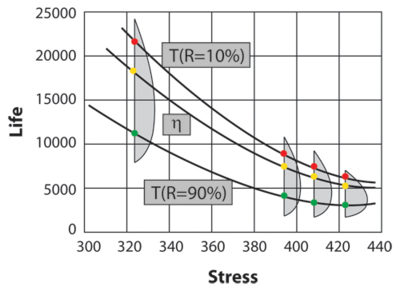
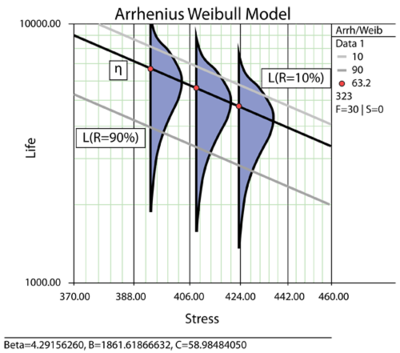

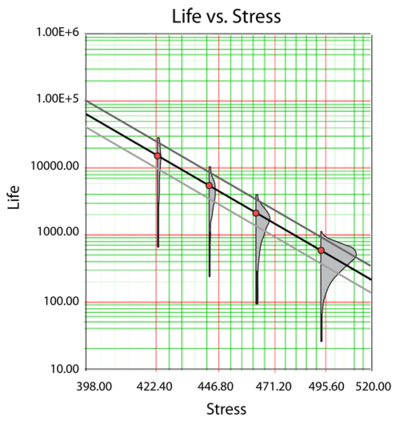
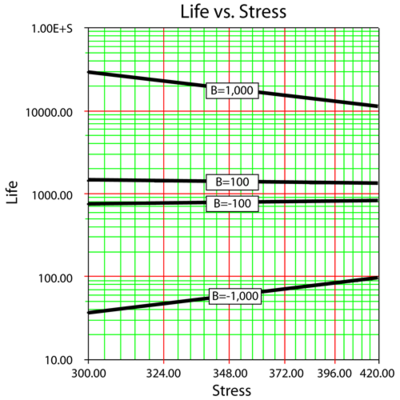

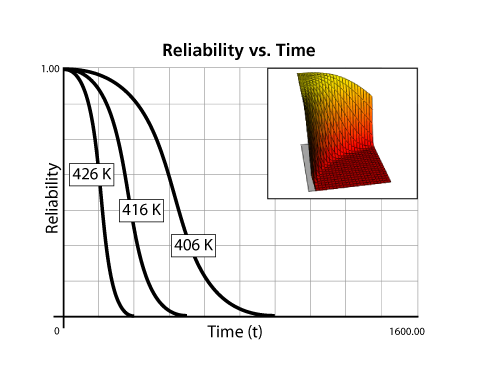
![Reliability function for [math]\displaystyle{ \Beta\lt 1 \,\! }[/math], [math]\displaystyle{ \Beta=1 \,\! }[/math], and [math]\displaystyle{ \Beta\gt 1 \,\! }[/math].](/images/b/bb/ALTA6.8.png)
![Failure rate function for [math]\displaystyle{ \Beta\lt 1 \,\! }[/math], [math]\displaystyle{ \Beta=1 \,\! }[/math], and [math]\displaystyle{ \Beta\gt 1 \,\! }[/math].](/images/c/ce/ALTA6.9.png)
